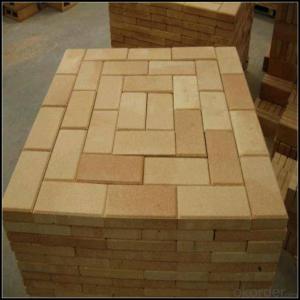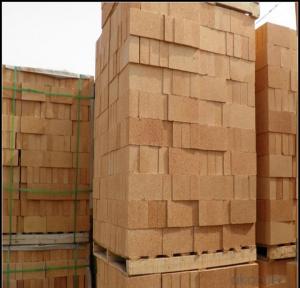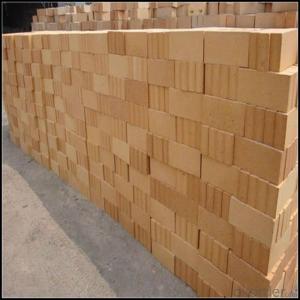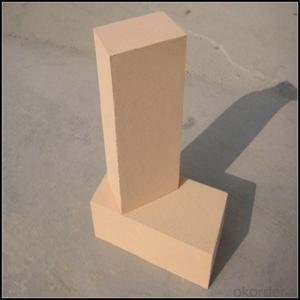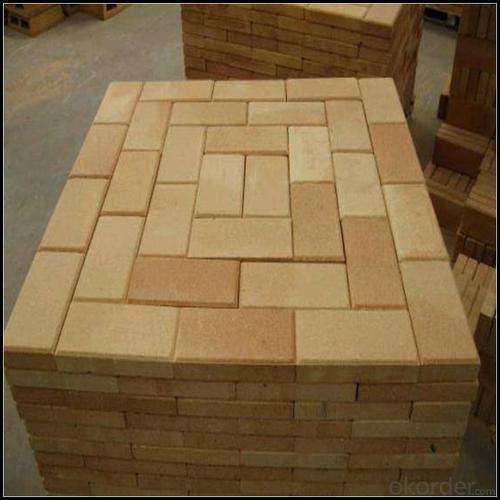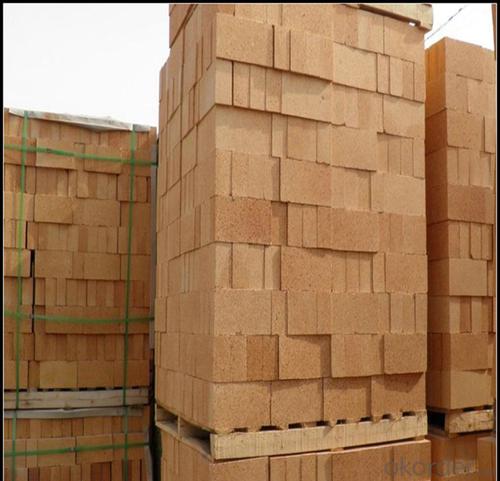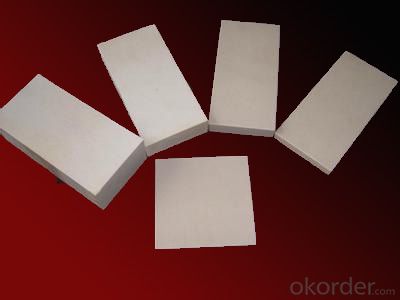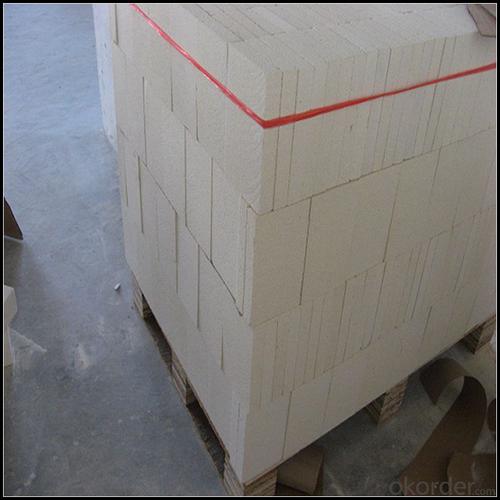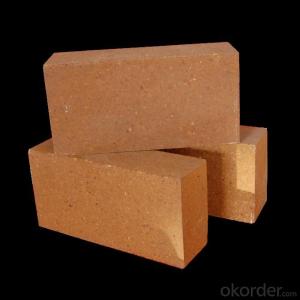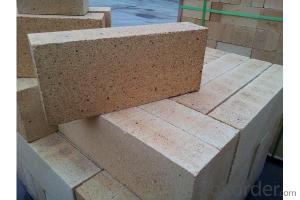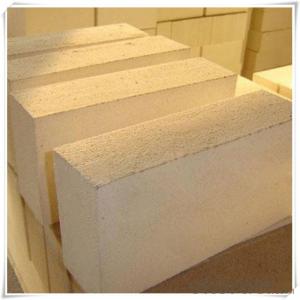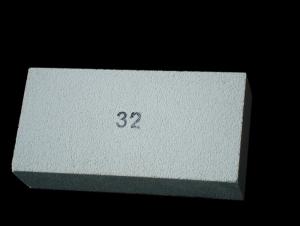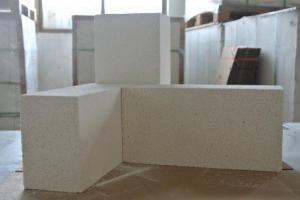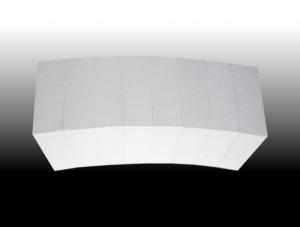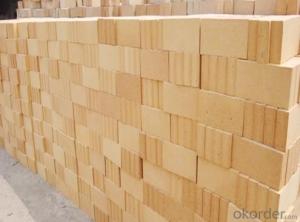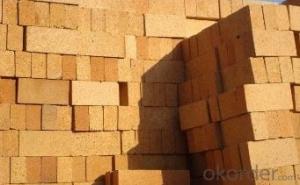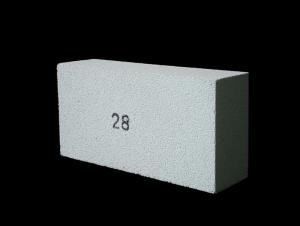Insulating Fire Brick for Cement Kilns
- Loading Port:
- China main port
- Payment Terms:
- TT OR LC
- Min Order Qty:
- 2 m.t
- Supply Capability:
- 600 m.t/month
OKorder Service Pledge
OKorder Financial Service
You Might Also Like
Refractory Brick
CMAX firebricks are classified under temperature between 1300℃ to 1700℃, manufactured from high purity alumina clay by mixing, press-forming, drying, sintering and machining. Bricks contain carefully-graded organic fillers which are burned out during sintering to give a uniform controllable pore structure. This technique makes product feature low thermal conductivity and excellent heat insulation
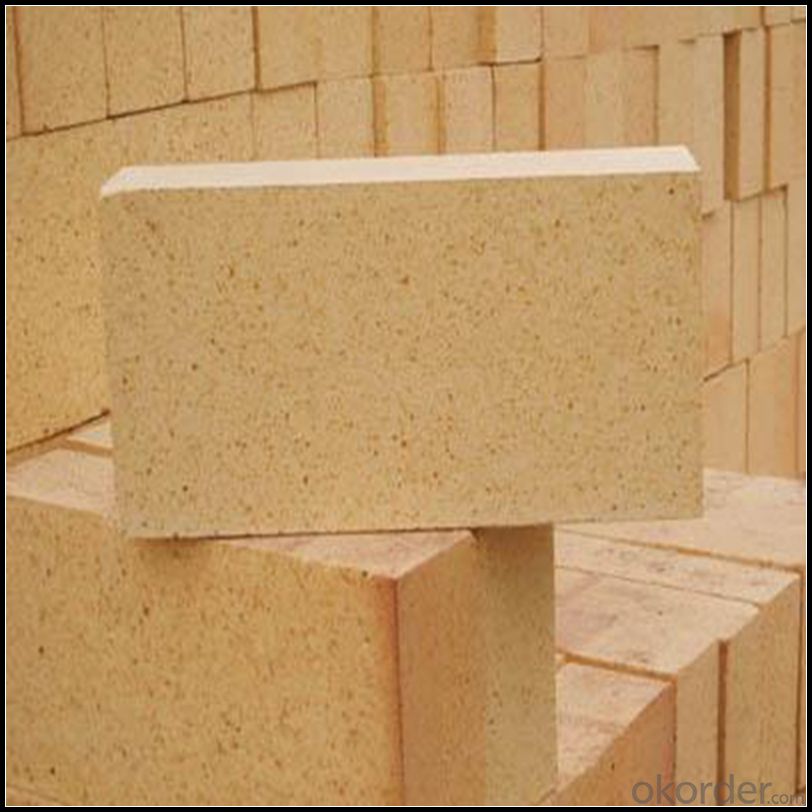
Features
a) Low thermal conductivity;
b) High refractoriness;
c) High mechanical strength;
d) Excellent thermal shock resistance;
e) Non standard sizes and shapes are available upon request.
High Alumina Brick
1. High refractoriness.
2. Good spalling resistance and wear resistance.
3. Good corrosion resistance.
4. Good thermal shock resistance.
5. High mechanical strength.
6. High-temperature creep rate is low.
7. Good volume stability at high temperature.
Application
1.Carbon bake furnaces in the aluminum industry
2.Preheat zones and cyclones of rotary cement kilns
3.insulation for glass tanks
4.Coke ovens
5.Blast furnaces
6.Reheating furnaces
7.Suspended roofs
8.Lime kilns
9.Chimney
10.BBQ/Pizza Ovens
Data Sheet
Classification Temperature (℉/℃) | 3000/1650 |
Bulk Density (g/cm3 ) | ≤1.0 |
Thermal Conductivity | |
800℃, W/m.K | ≤0.39 |
1000℃, W/m.K | ≤0.43 |
1200℃, W/m.K | ≤0.48 |
Reheating Linear Change (%) | 1550℃×12h |
≤0.9 | |
Chemical Composition (%) | |
Al2O3 | ≥75 |
Fe2O3 | ≤0.5 |
Packaging & Shipping
Packaging Details:Be packed in fumigated wooden pallets
Delivery Detail: 30 days after order

Our Services
Optimum solution and product supply of refractories for high temperature industries, such as iron steel, non-ferrous, petrochemical and building materials.
Engineering design, contract and consult for refractories, and civil architecture design.
Research, development, manufacture and sale of superhard materials.
R&D, manufacture and sale of special packing materials for export.
Inspection, supervision and arbitration of refractories.
Consultation and services in refractories information.
Training and cultivation of high-level talents in refractories profession
Sales Network

Company Information
CNBM (China National Building Material) Group is the largest comprehensive building materials group in China that in integrate scientific research, manufacturing and logistics into one entity. The largest building materials and equipment specialists in China. Upon State Council approval, today CNBM owned more than 300 subordinate manufacturing factories and servicing companies. There are 6 fully owned public listed companies and 11 partially owned with substantial shares public listed companies. In many of these fields, CNBM is playing the leading role in the building industry in the country.
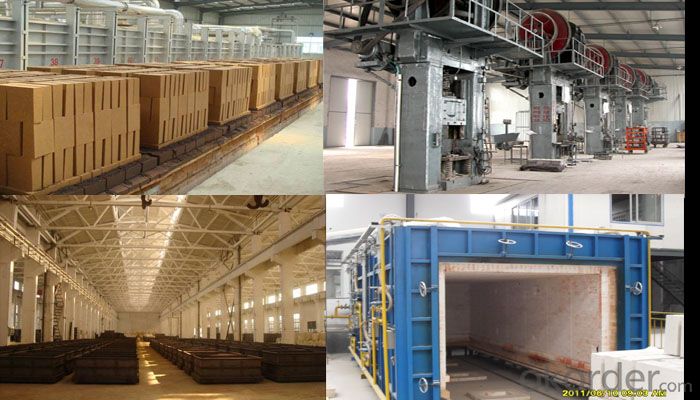
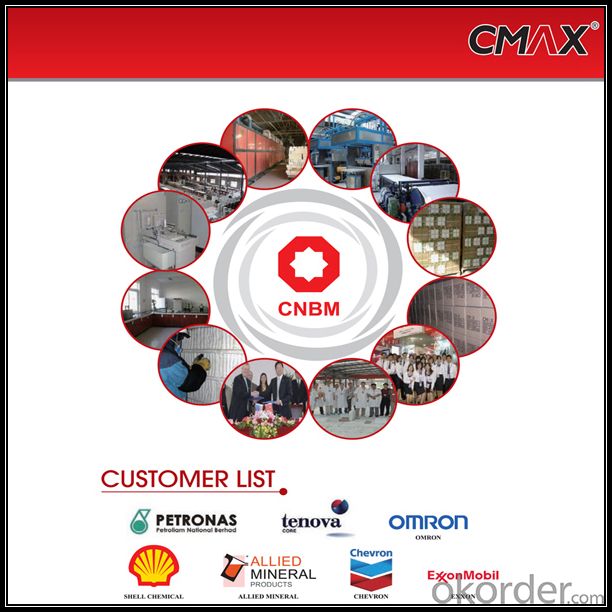
FAQ
1. Which products do you have?
We have all kinds of refractory brick, castable, mortar, cement, ceramic fiber products, etc.
Or you could browse our products to choose what you need.
2. Can you give me a brief introduction of the application of your products?
We are mainly specializing in the refractory materials in iron and steel, cement, glass, ceramics, petrochemical, electric power Industry, etc.
3. If I need your offer, what information do you need?
In order to choose suitable products, it will be appreciated to provide us the information, such us specification, technical data, order quantity, products application etc. If any question, please contact us freely.
- Q: Can insulating fire bricks be used in chimneys or flue systems?
- Insulating fire bricks have the ability to be utilized in chimneys or flue systems. They have been specifically engineered to endure high temperatures and offer exceptional insulation. Their typical usage involves situations where heat retention or reflection is necessary, such as in chimneys or flue systems. These bricks possess the capability to withstand temperatures of up to 3000°F (1650°C), which makes them highly suitable for implementation in environments with extreme heat. In addition, their insulation properties aid in reducing heat loss, improving energy efficiency, and preventing harm to surrounding structures. However, it is vital to note that the installation of insulating fire bricks must adhere to the manufacturer's instructions and local building codes to ensure safe and proper utilization.
- Q: Can insulating fire bricks be used in the construction of pottery ovens?
- Insulating fire bricks are suitable for the construction of pottery ovens. They possess exceptional thermal properties, including low thermal conductivity and high heat resistance. These characteristics make them perfect for insulation and heat retention in pottery ovens, facilitating efficient and controlled firing of clay and ceramic materials. Furthermore, their lightweight nature simplifies handling and installation during construction. Ultimately, incorporating insulating fire bricks in pottery ovens ensures consistent and uniform heat distribution, leading to enhanced firing results and energy efficiency.
- Q: Can insulating fire bricks be used in rocket stove designs?
- Yes, insulating fire bricks can be used in rocket stove designs. Rocket stoves are known for their efficient combustion and heat transfer, and insulating fire bricks can enhance this performance. These bricks are made from lightweight materials that have high insulating properties, allowing them to retain and reflect heat efficiently. In a rocket stove, the combustion chamber is typically lined with insulating fire bricks to maximize the heat transfer to the cooking surface or space being heated. The bricks help to retain heat within the combustion chamber, ensuring that more of the energy from the burning fuel is used to heat the cooking surface rather than being lost to the environment. Additionally, insulating fire bricks can withstand high temperatures, making them ideal for rocket stove designs. They are designed to handle the intense heat produced by the combustion process, ensuring the bricks won't crack or break under these conditions. Overall, using insulating fire bricks in rocket stove designs can improve the stove's efficiency and heat transfer, resulting in a more effective and sustainable cooking or heating solution.
- Q: Can insulating fire bricks be recycled?
- Certainly, it is possible to recycle insulating fire bricks. These bricks are commonly composed of clay, alumina, and silica, among other materials, that can be disassembled and repurposed. The recycling process entails crushing the bricks into smaller fragments, subsequently utilizing them as aggregate in diverse construction projects. By adopting this method, waste is diminished, and resources are conserved, rendering it an eco-friendly alternative to disposing of these bricks. Furthermore, certain companies provide dedicated recycling programs for insulating fire bricks, enabling both individuals and businesses to conveniently recycle them instead of resorting to landfills.
- Q: How do insulating fire bricks affect the overall weight capacity of a structure?
- Insulating fire bricks can have a significant impact on the overall weight capacity of a structure. These bricks are specifically designed to have low density and high thermal insulation properties, which means they are lightweight compared to traditional dense firebricks. By using insulating fire bricks, the overall weight of the structure is reduced, allowing for more weight to be allocated to other components or materials. This is particularly beneficial in situations where weight restrictions are a concern, such as in aerospace, automotive, or marine applications. Moreover, the lightweight nature of insulating fire bricks reduces the overall load on the foundation and supporting structures. This can help prevent structural damage and increase the safety and longevity of the entire structure. However, it is important to note that while insulating fire bricks are lighter, they may have slightly lower compressive strength compared to dense firebricks. Therefore, it is crucial to carefully consider the specific requirements of the structure and ensure that the chosen insulating fire bricks can withstand the anticipated load and stresses. In summary, insulating fire bricks positively affect the overall weight capacity of a structure by reducing its overall weight and decreasing the load on supporting structures. However, it is essential to consider the specific application and choose the appropriate insulating fire bricks to ensure structural integrity and safety.
- Q: Can insulating fire bricks be used in the construction of ceramic tile kilns?
- Insulating fire bricks are suitable for constructing ceramic tile kilns. These bricks are specially designed to endure elevated temperatures and possess exceptional insulation properties. By having low thermal conductivity, they effectively trap heat inside the kiln, preventing its escape and enhancing the firing process of ceramic tiles. Moreover, their lightweight quality makes them convenient to handle and install within the kiln structure. Ultimately, incorporating insulating fire bricks in the construction of ceramic tile kilns enhances energy efficiency, diminishes heat loss, and guarantees consistent and regulated firing temperatures.
- Q: Is it possible to recycle broken insulating fire bricks?
- It is indeed feasible to recycle damaged insulating fire bricks. These bricks are typically composed of recyclable materials like clay and alumina. After breaking, they can be crushed into tiny particles or ground into a fine powder. These fragments can then be blended with other substances to produce fresh bricks or alternative construction materials. Furthermore, certain recycling facilities may accept broken insulating fire bricks and repurpose them for use in various industries. By recycling these bricks, waste is minimized, resources are conserved, and the environmental consequences of manufacturing new bricks from scratch are reduced.
- Q: Are insulating fire bricks resistant to erosion from flowing gases or liquids?
- Yes, insulating fire bricks are generally resistant to erosion from flowing gases or liquids. Insulating fire bricks are designed to have good thermal insulation properties and to withstand high temperatures, making them suitable for various industrial applications. These bricks are made from lightweight refractory materials that have low porosity, which helps to minimize the penetration of gases and liquids. Additionally, insulating fire bricks are often chemically inert, which further enhances their resistance to erosion. However, it is important to note that the specific resistance of insulating fire bricks to erosion may vary depending on the composition and manufacturing process of the brick, as well as the nature and intensity of the flowing gases or liquids. Therefore, it is advisable to consult with the manufacturer or a qualified professional to determine the suitability of insulating fire bricks for a specific application.
- Q: What is the maximum temperature range of high temperature resistant insulation materials?
- High temperature insulation materials have many, the highest temperature range, specific material.For example, refractory bricks can withstand high temperatures between 1580 and 1770 degrees Celsius
- Q: Do insulating fire bricks require any special insulation blankets or jackets?
- Yes, insulating fire bricks do require special insulation blankets or jackets in order to enhance their insulating properties and protect them from heat loss and damage. These blankets or jackets help to create a barrier that prevents the transfer of heat, ensuring maximum insulation and energy efficiency.
Send your message to us
Insulating Fire Brick for Cement Kilns
- Loading Port:
- China main port
- Payment Terms:
- TT OR LC
- Min Order Qty:
- 2 m.t
- Supply Capability:
- 600 m.t/month
OKorder Service Pledge
OKorder Financial Service
Similar products
Hot products
Hot Searches
Related keywords
